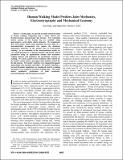| dc.contributor.author | Endo, Ken | |
| dc.contributor.author | Herr, Hugh M. | |
| dc.date.accessioned | 2010-10-13T19:34:16Z | |
| dc.date.available | 2010-10-13T19:34:16Z | |
| dc.date.issued | 2009-12 | |
| dc.date.submitted | 2009-10 | |
| dc.identifier.isbn | 978-1-4244-3803-7 | |
| dc.identifier.other | INSPEC Accession Number: 11009977 | |
| dc.identifier.uri | http://hdl.handle.net/1721.1/59292 | |
| dc.description.abstract | In this paper, we present an under-actuated model of human walking, comprising only a soleus muscle and flexion/extension monoarticular hip muscles. The remaining muscle groups of the human leg are modeled using quasi-passive, series-elastic clutch elements. We hypothesize that series-elastic clutch units spanning the knee joint in a musculoskeletal arrangement can capture the dominant mechanical behaviors of the human knee in level-ground walking. As an evaluation of the musculoskeletal model, we vary model parameters, or spring constants, and muscle control parameters using an optimization scheme that maximizes walking distance and minimizes the mechanical economy of walking. We used a positive force feedback reflex control for the model's soleus muscle, and upper body position control for the hip muscles. The model's clutches were engaged/disengaged using simple state machine controllers. For model evaluation, a forward dynamics simulation was conducted, and the resulting mechanics were compared to human walking data. The model makes qualitative predictions of joint mechanics, electromyography and mechanical economy. | en_US |
| dc.language.iso | en_US | |
| dc.publisher | Institute of Electrical and Electronics Engineers | en_US |
| dc.relation.isversionof | http://dx.doi.org/10.1109/IROS.2009.5354230 | en_US |
| dc.rights | Article is made available in accordance with the publisher's policy and may be subject to US copyright law. Please refer to the publisher's site for terms of use. | en_US |
| dc.source | IEEE | en_US |
| dc.title | Human walking model predicts joint mechanics, electromyography and mechanical economy | en_US |
| dc.type | Article | en_US |
| dc.identifier.citation | Endo, K., and H. Herr. “Human walking model predicts joint mechanics, electromyography and mechanical economy.” Intelligent Robots and Systems, 2009. IROS 2009. IEEE/RSJ International Conference on. 2009. 4663-4668. © Copyright 2010 IEEE | en_US |
| dc.contributor.department | Massachusetts Institute of Technology. Department of Electrical Engineering and Computer Science | en_US |
| dc.contributor.department | Massachusetts Institute of Technology. Media Laboratory | en_US |
| dc.contributor.approver | Herr, Hugh M. | |
| dc.contributor.mitauthor | Endo, Ken | |
| dc.contributor.mitauthor | Herr, Hugh M. | |
| dc.relation.journal | Proceedings of the IEEE/RSJ International Conference on Intelligent Robots and Systems, 2009 | en_US |
| dc.eprint.version | Final published version | en_US |
| dc.type.uri | http://purl.org/eprint/type/JournalArticle | en_US |
| eprint.status | http://purl.org/eprint/status/PeerReviewed | en_US |
| dspace.orderedauthors | Endo, Ken; Herr, Hugh | en |
| dc.identifier.orcid | https://orcid.org/0000-0003-3169-1011 | |
| mit.license | PUBLISHER_POLICY | en_US |
| mit.metadata.status | Complete | |
